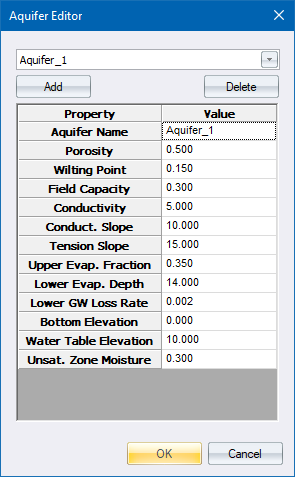
Create or edit Aquifer objects.
|
Icon |
Command |
Shortcut Key |
Toolbar |
|
|
STORMSWMMAQUIFERSDLG |
|
|
Aquifers are sub-surface groundwater areas used to model the vertical movement of water infiltrating from the subcatchments that lie above them. They also permit the infiltration of groundwater into the drainage system, or exfiltration of surface water from the drainage system, depending on the hydraulic gradient that exists. The same aquifer object can be shared by several subcatchments. Aquifers are only required in models that need to explicitly account for the exchange of groundwater with the drainage system, or to establish base flow and recession curves in natural channels and non-urban systems.
Aquifers are represented using two zones - an unsaturated zone and a saturated zone.
Their behaviour is characterised using such parameters as soil porosity, hydraulic conductivity, evapotranspiration depth, bottom elevation, and loss rate to deep groundwater. In addition, the initial water table elevation and initial moisture content of the unsaturated zone must be supplied.
Aquifers are connected to subcatchments, and to drainage system nodes as defined in a subcatchment's Groundwater Flow property. This property also contains parameters that govern the rate of groundwater flow between the aquifer's saturated zone and the drainage system node.
Procedure

The table allows you to specify the infiltration parameters for the aquifer.
See Also Groundwater Flow Editor